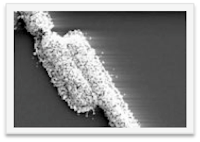|| Science Article |
Computers are shrinking but grow ever more powerful as designers find better ways of cramming more hardware into less space. Today’s mobile phones match the computing capacity of desktops less than a decade ago, and the finish line in the race for even more powerful devices is not likely to appear in the near future. Even the brain, which is the paragon of all computers—organic or otherwise—is fair ground for cutting edge designers keen on enhancing its already formidable capabilities.
In a feat that fuses mind and machine, European researchers from the University of Padua in Italy developed “neuro-chips”, wherein electronic circuitry meld with living brain cells. The researchers used a silicon chip that measured just a square millimeter to contain 16,000 electronic transistors and hundreds of capacitors. They then attached brain cells—called neurons—onto the chip using specialized proteins found in the brain as adhesives. In addition to gluing neurons onto the chip, these specialized proteins, according to team member Stefano Vassanelli, also “provided the link between ionic channels of the neurons and semiconductor material in a way that neural electrical signals could be passed to the silicon chip.”
In simpler terms, the specialized proteins acted as translators or middlemen when brain cells and electronic components interact. The silicon chip’s transistors recorded electrical signals transmitted by the brain cells while the capacitors were used to stimulate the neurons.
Some observers claim that the feat could jumpstart the development of highly sophisticated brain implants that treat neurological disorders. Others believe that the achievement could lead to organic computers that do hyper speed calculations using living neurons. However, it may take decades before the technology is brought to the stage where it might do either. In the near future, though, the living circuit could be utilized for screening different, brain-altering drugs. "Pharmaceutical companies could use the chip to test the effect of drugs on neurons, to quickly discover promising avenues of research," Vassanelli said.
Big Things Start from Small Beginnings
The term microcomputer takes on a literal meaning as scientists transform bacteria into a living computer hardware.
In 2005, just months before the development of the neuro-chips, a team from the University of Nebraska in the United States developed the “cellborg,” a hybrid of microbe and machine whose potential use as sensory devices might be unlimited.
Initially, the team coated a silicon chip with live Bacillus cereus bacteria, with clumps of the microorganisms forming a bridge between one etched electrode and another. The chip was then washed in a solution containing gold particles. Each of the gold particles was just about 30 nanometers across (The diameter of human hair is around 100,000 nanometers). The result was a bioelectronic device that responds to atmospheric humidity—the living sensor swelled and contracted, depending on the amount of water vapor in the air. The team called the device—which is at least four times more sensitive than its purely electronic counterparts—a cellborg humidity sensor. This development commenced what might be a race to produce more cellborgs that could sense different gases or dangerous substances.




